Yuan Feng
University of California, Merced, USA
AttnCache: Accelerating Self-Attention Inference for LLM Prefill via Attention Cache
Oct 29, 2025Abstract:Large Language Models (LLMs) are widely used in generative applications such as chatting, code generation, and reasoning. However, many realworld workloads such as classification, question answering, recommendation, and text embedding rely solely on the prefill stage of inference, where the model encodes input sequences without performing autoregressive decoding. In these prefill only scenarios, the self-attention computation becomes the primary performance bottleneck due to its quadratic complexity with respect to sequence length. In this paper, we observe that semantically different sentences often produce similar attention maps across layers and heads. Building on this insight, we propose AttnCache, a framework that accelerates the prefill stage of LLM inference by retrieving and reusing similar attention maps. Based on an attention map memorization database, AttnCache employs efficient caching and similarity search techniques to identify and reuse pre-cached attention maps during inference, thereby reducing the computational overhead of self-attention. Experimental results show that AttnCache achieves an average of 1.2x end-to-end and 2x attention speedup on CPU, and 1.6x end-to-end and 3x attention speedup on GPU, with negligible accuracy degradation.
Social Robots for People with Dementia: A Literature Review on Deception from Design to Perception
Jul 01, 2025Abstract:As social robots increasingly enter dementia care, concerns about deception, intentional or not, are gaining attention. Yet, how robotic design cues might elicit misleading perceptions in people with dementia, and how these perceptions arise, remains insufficiently understood. In this scoping review, we examined 26 empirical studies on interactions between people with dementia and physical social robots. We identify four key design cue categories that may influence deceptive impressions: cues resembling physiological signs (e.g., simulated breathing), social intentions (e.g., playful movement), familiar beings (e.g., animal-like form and sound), and, to a lesser extent, cues that reveal artificiality. Thematic analysis of user responses reveals that people with dementia often attribute biological, social, and mental capacities to robots, dynamically shifting between awareness and illusion. These findings underscore the fluctuating nature of ontological perception in dementia contexts. Existing definitions of robotic deception often rest on philosophical or behaviorist premises, but rarely engage with the cognitive mechanisms involved. We propose an empirically grounded definition: robotic deception occurs when Type 1 (automatic, heuristic) processing dominates over Type 2 (deliberative, analytic) reasoning, leading to misinterpretation of a robot's artificial nature. This dual-process perspective highlights the ethical complexity of social robots in dementia care and calls for design approaches that are not only engaging, but also epistemically respectful.
Serving Large Language Models on Huawei CloudMatrix384
Jun 15, 2025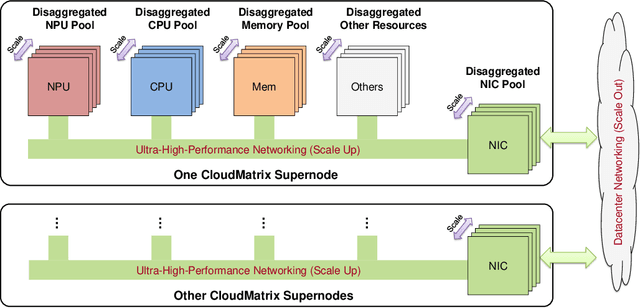

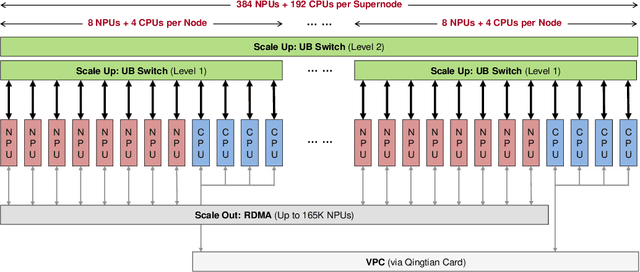
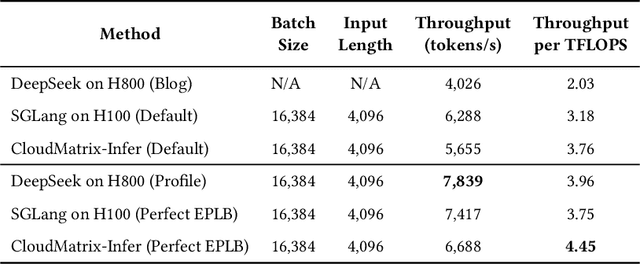
Abstract:The rapid evolution of large language models (LLMs), driven by growing parameter scales, adoption of mixture-of-experts (MoE) architectures, and expanding context lengths, imposes unprecedented demands on AI infrastructure. Traditional AI clusters face limitations in compute intensity, memory bandwidth, inter-chip communication, and latency, compounded by variable workloads and strict service-level objectives. Addressing these issues requires fundamentally redesigned hardware-software integration. This paper introduces Huawei CloudMatrix, a next-generation AI datacenter architecture, realized in the production-grade CloudMatrix384 supernode. It integrates 384 Ascend 910C NPUs and 192 Kunpeng CPUs interconnected via an ultra-high-bandwidth Unified Bus (UB) network, enabling direct all-to-all communication and dynamic pooling of resources. These features optimize performance for communication-intensive operations, such as large-scale MoE expert parallelism and distributed key-value cache access. To fully leverage CloudMatrix384, we propose CloudMatrix-Infer, an advanced LLM serving solution incorporating three core innovations: a peer-to-peer serving architecture that independently scales prefill, decode, and caching; a large-scale expert parallelism strategy supporting EP320 via efficient UB-based token dispatch; and hardware-aware optimizations including specialized operators, microbatch-based pipelining, and INT8 quantization. Evaluation with the DeepSeek-R1 model shows CloudMatrix-Infer achieves state-of-the-art efficiency: prefill throughput of 6,688 tokens/s per NPU and decode throughput of 1,943 tokens/s per NPU (<50 ms TPOT). It effectively balances throughput and latency, sustaining 538 tokens/s even under stringent 15 ms latency constraints, while INT8 quantization maintains model accuracy across benchmarks.
Today's Cat Is Tomorrow's Dog: Accounting for Time-Based Changes in the Labels of ML Vulnerability Detection Approaches
Jun 13, 2025Abstract:Vulnerability datasets used for ML testing implicitly contain retrospective information. When tested on the field, one can only use the labels available at the time of training and testing (e.g. seen and assumed negatives). As vulnerabilities are discovered across calendar time, labels change and past performance is not necessarily aligned with future performance. Past works only considered the slices of the whole history (e.g. DiverseVUl) or individual differences between releases (e.g. Jimenez et al. ESEC/FSE 2019). Such approaches are either too optimistic in training (e.g. the whole history) or too conservative (e.g. consecutive releases). We propose a method to restructure a dataset into a series of datasets in which both training and testing labels change to account for the knowledge available at the time. If the model is actually learning, it should improve its performance over time as more data becomes available and data becomes more stable, an effect that can be checked with the Mann-Kendall test. We validate our methodology for vulnerability detection with 4 time-based datasets (3 projects from BigVul dataset + Vuldeepecker's NVD) and 5 ML models (Code2Vec, CodeBERT, LineVul, ReGVD, and Vuldeepecker). In contrast to the intuitive expectation (more retrospective information, better performance), the trend results show that performance changes inconsistently across the years, showing that most models are not learning.
SkewRoute: Training-Free LLM Routing for Knowledge Graph Retrieval-Augmented Generation via Score Skewness of Retrieved Context
May 28, 2025Abstract:Large language models excel at many tasks but often incur high inference costs during deployment. To mitigate hallucination, many systems use a knowledge graph to enhance retrieval-augmented generation (KG-RAG). However, the large amount of retrieved knowledge contexts increase these inference costs further. A promising solution to balance performance and cost is LLM routing, which directs simple queries to smaller LLMs and complex ones to larger LLMs. However, no dedicated routing methods currently exist for RAG, and existing training-based routers face challenges scaling to this domain due to the need for extensive training data. We observe that the score distributions produced by the retrieval scorer strongly correlate with query difficulty. Based on this, we propose a novel, training-free routing framework, the first tailored to KG-RAG that effectively balances performance and cost in a plug-and-play manner. Experiments show our method reduces calls to larger LLMs by up to 50% without sacrificing response quality, demonstrating its potential for efficient and scalable LLM deployment.
Lego Sketch: A Scalable Memory-augmented Neural Network for Sketching Data Streams
May 26, 2025Abstract:Sketches, probabilistic structures for estimating item frequencies in infinite data streams with limited space, are widely used across various domains. Recent studies have shifted the focus from handcrafted sketches to neural sketches, leveraging memory-augmented neural networks (MANNs) to enhance the streaming compression capabilities and achieve better space-accuracy trade-offs.However, existing neural sketches struggle to scale across different data domains and space budgets due to inflexible MANN configurations. In this paper, we introduce a scalable MANN architecture that brings to life the {\it Lego sketch}, a novel sketch with superior scalability and accuracy. Much like assembling creations with modular Lego bricks, the Lego sketch dynamically coordinates multiple memory bricks to adapt to various space budgets and diverse data domains. Our theoretical analysis guarantees its high scalability and provides the first error bound for neural sketch. Furthermore, extensive experimental evaluations demonstrate that the Lego sketch exhibits superior space-accuracy trade-offs, outperforming existing handcrafted and neural sketches. Our code is available at https://github.com/FFY0/LegoSketch_ICML.
TrustGeoGen: Scalable and Formal-Verified Data Engine for Trustworthy Multi-modal Geometric Problem Solving
Apr 22, 2025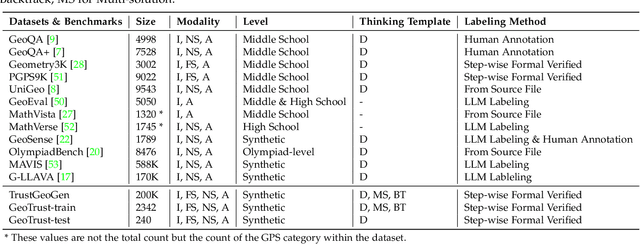
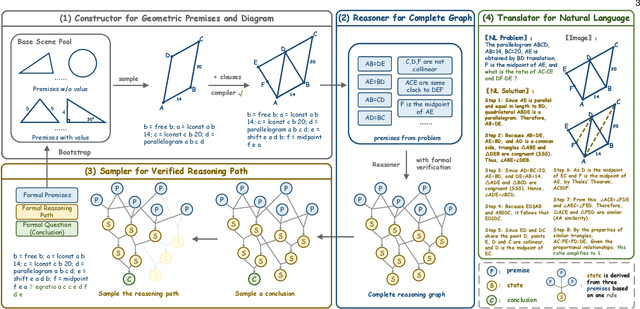
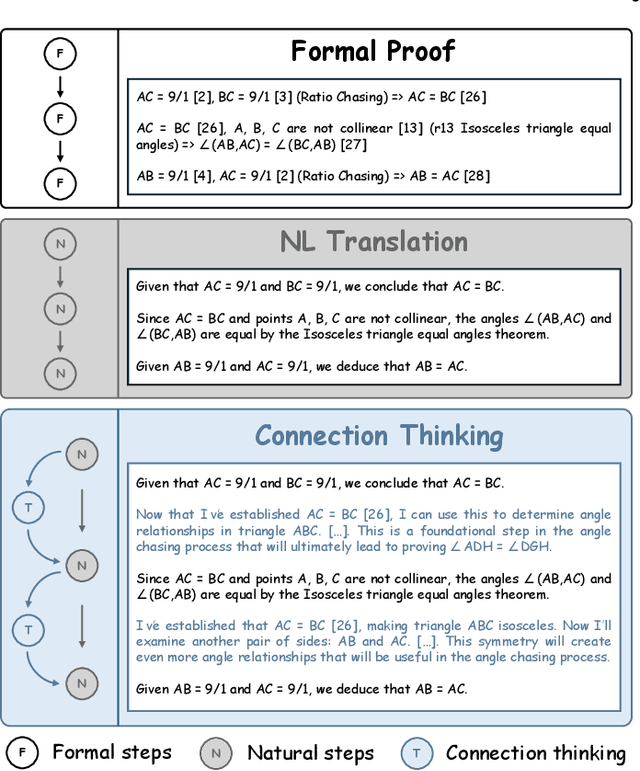

Abstract:Mathematical geometric problem solving (GPS) often requires effective integration of multimodal information and verifiable logical coherence. Despite the fast development of large language models in general problem solving, it remains unresolved regarding with both methodology and benchmarks, especially given the fact that exiting synthetic GPS benchmarks are often not self-verified and contain noise and self-contradicted information due to the illusion of LLMs. In this paper, we propose a scalable data engine called TrustGeoGen for problem generation, with formal verification to provide a principled benchmark, which we believe lays the foundation for the further development of methods for GPS. The engine synthesizes geometric data through four key innovations: 1) multimodal-aligned generation of diagrams, textual descriptions, and stepwise solutions; 2) formal verification ensuring rule-compliant reasoning paths; 3) a bootstrapping mechanism enabling complexity escalation via recursive state generation and 4) our devised GeoExplore series algorithms simultaneously produce multi-solution variants and self-reflective backtracking traces. By formal logical verification, TrustGeoGen produces GeoTrust-200K dataset with guaranteed modality integrity, along with GeoTrust-test testset. Experiments reveal the state-of-the-art models achieve only 49.17\% accuracy on GeoTrust-test, demonstrating its evaluation stringency. Crucially, models trained on GeoTrust achieve OOD generalization on GeoQA, significantly reducing logical inconsistencies relative to pseudo-label annotated by OpenAI-o1. Our code is available at https://github.com/Alpha-Innovator/TrustGeoGen
OLMD: Orientation-aware Long-term Motion Decoupling for Continuous Sign Language Recognition
Mar 11, 2025Abstract:The primary challenge in continuous sign language recognition (CSLR) mainly stems from the presence of multi-orientational and long-term motions. However, current research overlooks these crucial aspects, significantly impacting accuracy. To tackle these issues, we propose a novel CSLR framework: Orientation-aware Long-term Motion Decoupling (OLMD), which efficiently aggregates long-term motions and decouples multi-orientational signals into easily interpretable components. Specifically, our innovative Long-term Motion Aggregation (LMA) module filters out static redundancy while adaptively capturing abundant features of long-term motions. We further enhance orientation awareness by decoupling complex movements into horizontal and vertical components, allowing for motion purification in both orientations. Additionally, two coupling mechanisms are proposed: stage and cross-stage coupling, which together enrich multi-scale features and improve the generalization capabilities of the model. Experimentally, OLMD shows SOTA performance on three large-scale datasets: PHOENIX14, PHOENIX14-T, and CSL-Daily. Notably, we improved the word error rate (WER) on PHOENIX14 by an absolute 1.6% compared to the previous SOTA
Path Pooling: Train-Free Structure Enhancement for Efficient Knowledge Graph Retrieval-Augmented Generation
Mar 07, 2025Abstract:Although Large Language Models achieve strong success in many tasks, they still suffer from hallucinations and knowledge deficiencies in real-world applications. Many knowledge graph-based retrieval-augmented generation (KG-RAG) methods enhance the quality and credibility of LLMs by leveraging structure and semantic information in KGs as external knowledge bases. However, these methods struggle to effectively incorporate structure information, either incurring high computational costs or underutilizing available knowledge. Inspired by smoothing operations in graph representation learning, we propose path pooling, a simple, train-free strategy that introduces structure information through a novel path-centric pooling operation. It seamlessly integrates into existing KG-RAG methods in a plug-and-play manner, enabling richer structure information utilization. Extensive experiments demonstrate that incorporating the path pooling into the state-of-the-art KG-RAG method consistently improves performance across various settings while introducing negligible additional cost. Code is coming soon at https://github.com/hrwang00/path-pooling.
Identify Critical KV Cache in LLM Inference from an Output Perturbation Perspective
Feb 06, 2025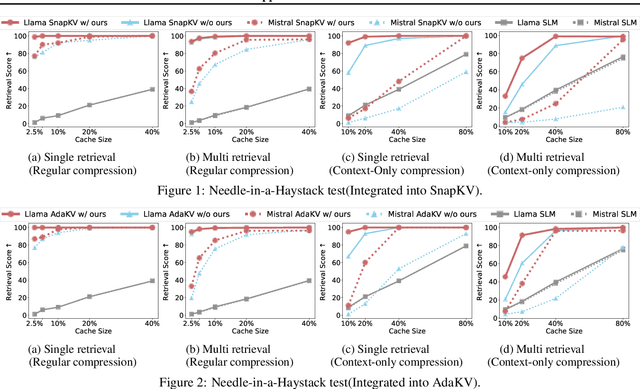
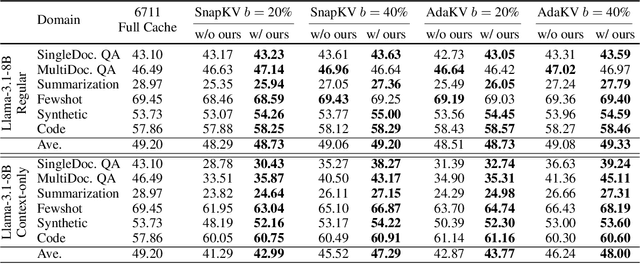
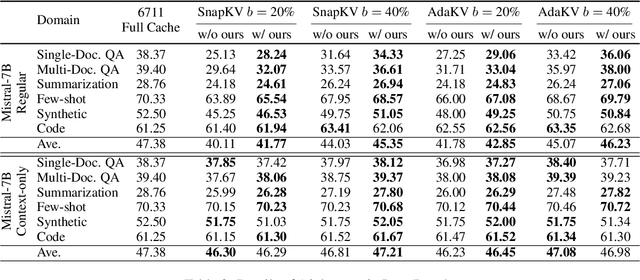

Abstract:Large language models have revolutionized natural language processing but face significant challenges of high storage and runtime costs, due to the transformer architecture's reliance on self-attention, particularly the large Key-Value (KV) cache for long-sequence inference. Recent efforts to reduce KV cache size by pruning less critical entries based on attention weights remain empirical and lack formal grounding. This paper presents a formal study on identifying critical KV cache entries by analyzing attention output perturbation. Our analysis reveals that, beyond attention weights, the value states within KV entries and pretrained parameter matrices are also crucial. Based on this, we propose a perturbation-constrained selection algorithm that optimizes the worst-case output perturbation to identify critical entries. Evaluations on the Needle-in-a-Haystack test and Longbench benchmark show our algorithm enhances state-of-the-art cache eviction methods. Further empirical analysis confirms that our algorithm achieves lower output perturbations in over 92% attention heads in Llama model, thereby providing a significant improvement over existing methods.
 Add to Chrome
Add to Chrome Add to Firefox
Add to Firefox Add to Edge
Add to Edge